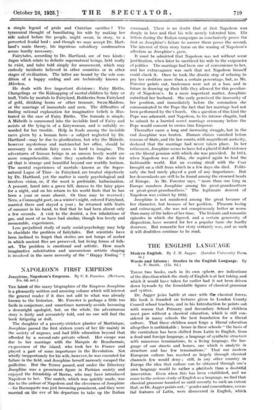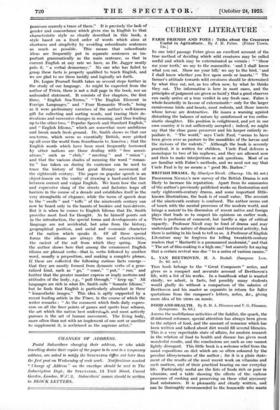THE ENGLISH LANGUAGE
Words and Idioms : Studies in the English Language. By L. P. Smith. (12s. 6d.) THESE two books, each in its own sphere, are indications of the direction which the study of English is at last taking, and which it would have taken far earlier had it not been driven down byroads by the formidable figures of classical grammar
and syntax.
Dr. Jagger joins battle at once with the classical forces.
His book is founded on lectures given to London County Council school teachers, and in his Introduction he points out with reason that Primary and Secondary School children must pass without a classical education, which is still con- sidered in many schools the best foundation for a liberal culture. That these children must forgo a liberal education altogether is unthinkable ; hence in these schools " the basis of
the curriculum has been shifted from Latin to English, from a dead-and foreign language, a language of synthetic structure with numerous terminations, to a living language, the lan- guage of our streets and homes, one which is analytic in structure and has few terminations." That our modern European culture has reached us largely through classical channels few would deny ; still, in any other country in Europe the idea that culture can be obtained through one's own language would be rather a platitude than a doubtful innovation. Even when this has been established, and we come to the serious study of English as a language, we find that classical grammar haunted us until recently to such an extent that, as Dr. Jagger points out, " gender and concordance, essen-
tial features of Latin, were discovered in English, which possesses scarcely a trace of them." It is precisely the lack of gender and concordance which gives rise in English to that characteristic style so clearly described in this book, a style based on a fixed order of words which aims at shortness and simplicity by avoiding subordinate sentences as much as possible. This means that subordinate ideas are frequently put in separate sentences as im- portant grammatically as the main sentence, so that in current English at any rate we have, as Dr. Jagger neatly puts it, " a verbal democracy." No one who has failed to grasp these facts is properly qualified to teach Engliah, and we are glad to see them lucidly and logically set forth.
Dr. Logan Pearsall Smith takes us several steps further in the study of our language. As might be expected from the author of Trivia, there is not a dull page in the book, nor an unfounded statement. It consists of five chapters, the first three, " English Sea-Terms," " The English Element in Foreign Languages," and " Four Romantic Words," being as it were preliminary exercises of the author's well-known gift for collecting and sorting words, and tracing their de- - rivations and successive changes in meaning, and thus leading up to the other two, " Popular Speech and Standard English," and " English Idioms," which are somewhat more ambitious and break much fresh ground. Dr. Smith shows us that our sea-terms, which seem so essentially British, were picked up all over the world from Scandinavia to America ; that the English words which have been most frequently borrowed by other nations are those dealing with " free associ- ations," such as " club," " meeting " and " union " ; and that the various shades of meaning the word " roman- tic " has taken on during its existence can be used to trace the history of that great literary movement of the eighteenth century. The paper on popular speech is an object-lesson on the vanity of drawing a hard-and-fast line between correct and vulgar English. We learn how the curt and expressive slang of the streets and factories leaps all barriers in the course of a decade and establishes itself in the very strongholds of elegance, while the turns of speech dear to the " swells " and " toffs " of the nineteenth century can now be heard only in the haunts of bookies and taxi-drivers.
But it is when he comes to English Idioms that Dr. 'Smith provides most food for thought. As he himself points out in the introduction, the special forms and developments of a language are not accidental, but arise from the history, geographical position, and social and- economic character - of the nation which speaks it. Of all these special forms the idioms are always _ the most characteristic, the raciest of the soil from which they spring. Now the author shows here that among the commonest English_ idioms are phrasal verbs—that is, verbs followed by another word, usually a preposition, and making a complete phrase..
If these are collected the following curious facts emerge— that they are mostly formed from dynamic verbs of a gene- ralized kind, such as " go," " come," " put," " run," and further that the greater number express or imply motions and attitudes of the body, e.g., " pull through," keep up." All languages are rich in what Dr. Smith calls " Somatic Idioms," but he finds that English is particularly abundant in these- " kinaesthetic images." This idea is aptly supported by a. recent leading article in the Times, in the course of which the writer remarks : " As the comment which finds daily expres- sion on all the finer points of games and sports bear witness, the art which the nation best imderstezid.s and most actively . pursues is the art of human movement. The living body,, more often than not with an implement of one sort or another to supplement it, is acclaimed as the supreme artist."































































 Previous page
Previous page